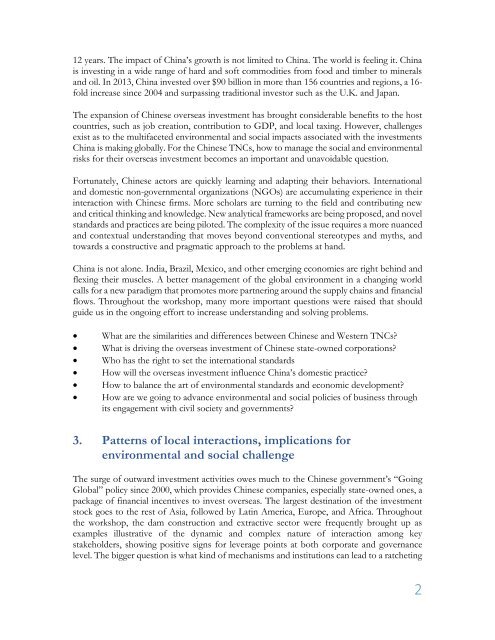Yale-WWF_final
Yale-WWF_final
Yale-WWF_final
Create successful ePaper yourself
Turn your PDF publications into a flip-book with our unique Google optimized e-Paper software.
12 years. The impact of China’s growth is not limited to China. The world is feeling it. Chinais investing in a wide range of hard and soft commodities from food and timber to mineralsand oil. In 2013, China invested over $90 billion in more than 156 countries and regions, a 16-fold increase since 2004 and surpassing traditional investor such as the U.K. and Japan.The expansion of Chinese overseas investment has brought considerable benefits to the hostcountries, such as job creation, contribution to GDP, and local taxing. However, challengesexist as to the multifaceted environmental and social impacts associated with the investmentsChina is making globally. For the Chinese TNCs, how to manage the social and environmentalrisks for their overseas investment becomes an important and unavoidable question.Fortunately, Chinese actors are quickly learning and adapting their behaviors. Internationaland domestic non-governmental organizations (NGOs) are accumulating experience in theirinteraction with Chinese firms. More scholars are turning to the field and contributing newand critical thinking and knowledge. New analytical frameworks are being proposed, and novelstandards and practices are being piloted. The complexity of the issue requires a more nuancedand contextual understanding that moves beyond conventional stereotypes and myths, andtowards a constructive and pragmatic approach to the problems at hand.China is not alone. India, Brazil, Mexico, and other emerging economies are right behind andflexing their muscles. A better management of the global environment in a changing worldcalls for a new paradigm that promotes more partnering around the supply chains and financialflows. Throughout the workshop, many more important questions were raised that shouldguide us in the ongoing effort to increase understanding and solving problems.What are the similarities and differences between Chinese and Western TNCs?What is driving the overseas investment of Chinese state-owned corporations?Who has the right to set the international standardsHow will the overseas investment influence China’s domestic practice?How to balance the art of environmental standards and economic development?How are we going to advance environmental and social policies of business throughits engagement with civil society and governments?3. Patterns of local interactions, implications forenvironmental and social challengeThe surge of outward investment activities owes much to the Chinese government’s “GoingGlobal” policy since 2000, which provides Chinese companies, especially state-owned ones, apackage of financial incentives to invest overseas. The largest destination of the investmentstock goes to the rest of Asia, followed by Latin America, Europe, and Africa. Throughoutthe workshop, the dam construction and extractive sector were frequently brought up asexamples illustrative of the dynamic and complex nature of interaction among keystakeholders, showing positive signs for leverage points at both corporate and governancelevel. The bigger question is what kind of mechanisms and institutions can lead to a ratcheting2


